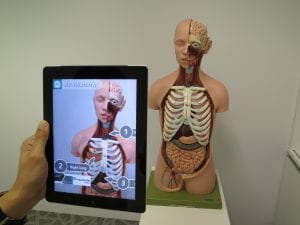AR APPLICATIONS IN CLASSROOMS – Part 2
The interactive and innovative nature of technology has often been cited as a positive influence on educational outcomes, and this benefit extends to the inclusion of AR in schooling (Oddone, 2019). AR can be used to improve student engagement, address curriculum outcomes and increase digital literacy skills (Oddone, 2019; Saidin, Abd Hali & Yahaya, 2015). It can be used in inquiry learning, recreational and informational reading, improving literacy and numeracy standards, developing STEM and ICT skills, supporting literary arts, visual arts and developing social emotional learning (Saidin, Abd Hali & Yahaya, 2015). Like VR, AR expands learning beyond the textbook and classroom walls, as well as builds those critical digital literacy skills for life beyond the classroom (Wolz, 2019, p.3; Wu et al., 2014).
The most sizable and unique benefit AR has on educational practices is that it uses 3D images to illustrate complex concepts to students (Zak, 2014). By creating these images, AR enables the student to feel a sense of immediacy and immersion which fosters a realistic experience (Wu et al., 2013, p.44). This realistic experience increases the frequency and depth of connections made between the student, the content and the real world (Hannah, Huber & Matei, 2019, p.278; Wu et al., 2013). AR requires the user to activate the augmented data, therefore it can be described as student centred, contextual to the user and is a constructivist approach to education, and consequently aligns itself along the current prevalent pedagogical theories (Wolz, 2019, p.2; Zak, 2014). Hence, when combined with holistic and authentic learning practices, AR has an immense capability to inspire affective learning.
REFERENCES
Hannah, M., Huber, S., & Matei, S. (2019). Collecting virtual and augmented reality in the twenty first century library. Collection Management, 44 (2-4), pp.277-295. DOI: 10.1080/01462679.2019.1587673
Oddone, K. (2019). Even better than the real thing? Virtual and augmented reality in the school library. SCIS Connections. (110). Retrieved from https://www.scisdata.com/media/1921/scis-connections-110.pdf
Saidin, N. Abd Halim, N., & Yahaya, N. (2015). A review of research on augmented reality in education: Advantages and applications. International Education Studies, 8(13). Retrieved from http://citeseerx.ist.psu.edu/viewdoc/download?doi=10.1.1.730.8456&rep=rep1&type=pdf
Wolz, K. (2019). Building faculty competence and self efficacy for using ZSpace virtual reality (VR) software in the classroom. All Regis University Theses. Retrieved from https://epublications.regis.edu/cgi/viewcontent.cgi?article=1930&context=theses
Wu, H., Lee, S., Chang, H., & Liang, J. (2013). Current status, opportunities and challenges of augmented realiy in education. Computers & Education, 62. Pp41-49. Retrieved from https://doi.org/10.1016/j.compedu.2012.10.024
Zak, E. (2014). Do you believe in magic? Exploring the conceptualisation of augmented reality and its implication for the user in the field of library and information science. Information Technology and Libraries.
